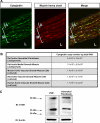Cytoglobin is expressed in the vasculature and regulates cell respiration and proliferation via nitric oxide dioxygenation
- PMID: 19147491
- PMCID: PMC2659212
- DOI: 10.1074/jbc.M808231200
Cytoglobin is expressed in the vasculature and regulates cell respiration and proliferation via nitric oxide dioxygenation
Abstract
Disposition of the second messenger nitric oxide (NO) in mammalian tissues occurs through multiple pathways including dioxygenation by erythrocyte hemoglobin and red muscle myoglobin. Metabolism by a putative NO dioxygenase activity in non-striated tissues has also been postulated, but the exact nature of this activity is unknown. In the present study, we tested the hypothesis that cytoglobin, a newly discovered hexacoordinated globin, participates in cell-mediated NO consumption. Stable expression of small hairpin RNA targeting cytoglobin in fibroblasts resulted in decreased NO consumption and intracellular nitrate production. These cells were more sensitive to NO-induced inhibition of cell respiration and proliferation, which could be restored by re-expression of human cytoglobin. We also demonstrated cytoglobin expression in adventitial fibroblasts as well as vascular smooth muscle cells from various species including human and found that cytoglobin was expressed in the adventitia and media of intact rat aorta. These results indicate that cytoglobin contributes to cell-mediated NO dioxygenation and represents an important NO sink in the vascular wall.
Figures








References
Publication types
MeSH terms
Substances
Grants and funding
LinkOut - more resources
Full Text Sources
Molecular Biology Databases

